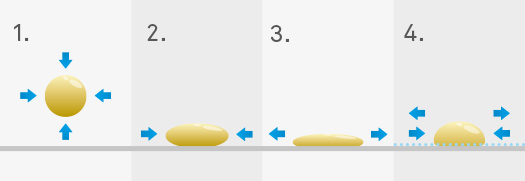EPILAME
A thin coat of NOXBARRIER® forms an invisible nanometer-thick film, called an “Epilame”, which reduces the surface tension of the substrate to a level where migration or spread of oil and grease is inhibited.
Typical Epilame application areas are micro-mechanical parts, gearwheels, bearings and ball bearings typically found in high-end mechanical devices (electric engines, scales, watches and instruments, etc.). In high speed ventilators they avoid the loss or migration of grease and protect the device even at high centripetal forces. The coating holds back oil that is moved by gears or screws and facilitates easy blow-back of the lubricant.
The figure shows the typical mode of an Epilame and how it avoids oil spreading on a surface. The ideal state is characterized in condition #4 of the diagram. An oil-droplet or film is kept in place by an equilibrium of cohesion and adhesion.

- Oil droplet (cohesive force)
- Oil droplet on surface – no wetting (cohesive force only), no oil adhesion
- Oil droplet on untreated surface – wetting (mainly adhesive force), oil spreading
- Oil droplet on Epilame – wetting without spreading (cohesion/adhesion at equilibrium)
The application of an epilame starts with a dip in a diluted emulsion (10-20 seconds) and drying for 1-2 minutes. The interfacial tension between oil and surface is now changed to a level where oil stops to migrate. Oil or grease remains in place or stops where the epilame appears. It stops from migrating and spreading like in front of a barrier. Treated parts keep their performance and the lifetime is extended.

The Epilames discussed based on NOXBARRIER® are PFOA and PFOS-free.


